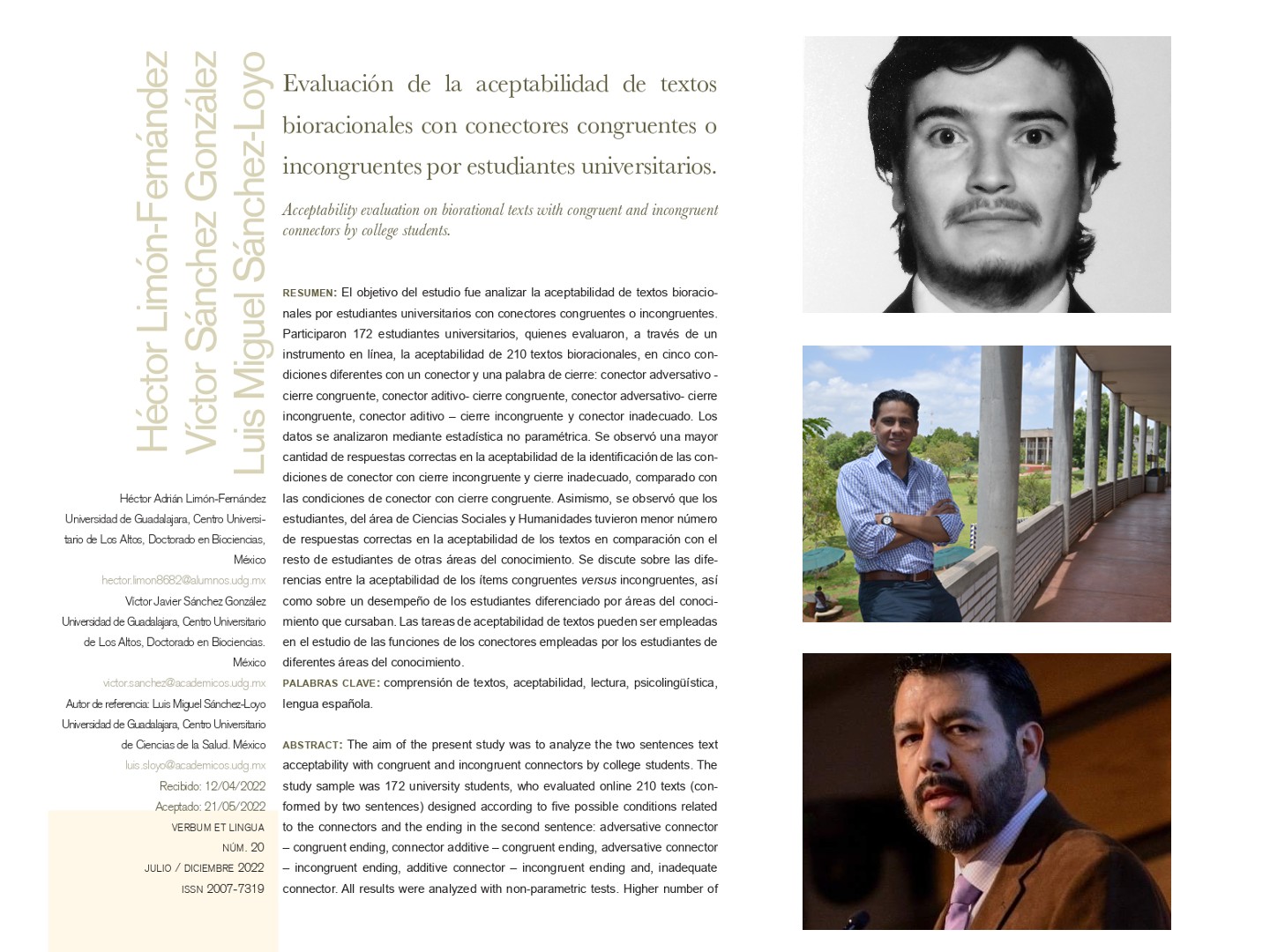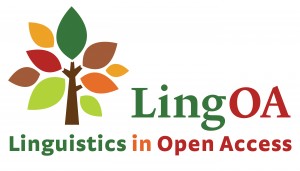Acceptability evaluation on biorational texts with congruent and incongruent connectors by college students.
DOI:
https://doi.org/10.32870/vel.vi20.183Keywords:
Text comprehension, Acceptability, Reading, Psycholinguistics, Spanish languageAbstract
The aim of the present study was to analyze the two sentences text acceptability with congruent and incongruent connectors by college students. The study sample was 172 university students, who evaluated online 210 texts (conformed by two sentences) designed according to five possible conditions related to the connectors and the ending in the second sentence: adversative connector – congruent ending, connector additive – congruent ending, adversative connector – incongruent ending, additive connector – incongruent ending and, inadequate connector. All results were analyzed with non-parametric tests. Higher number of correct responses in the acceptability was observed on the incongruent connector and inadequate connector conditions, compared with both congruent connector conditions. Likewise, meaningful differences were found on the correct responses score between areas of knowledge, where the students of the Social Sciences and Humanities area had the lowest score in the acceptability compared to the students of other areas of knowledge. Discussion remarks the differentiated the score of acceptability between congruent versus incongruent items, and the significant acceptability difference among knowledge areas of participants. Text acceptability tasks can be used to study the functions of connectors used by students from different areas of knowledge.
Downloads
Metrics
References
Alarcos, E. (2008). Gramática de la Lengua Española. México, D.F.: SEP/Planeta.
Alemán Bañón, J., Fiorentino, R., & Gabriele, A. (2012). The processing of number and gender agreement in Spanish: An event-related potential investigation of the effects of structural distance. Brain Research, 1456, 49–63. https://doi.org/10.1016/j.brainres.2012.03.057
Baretta, L., Braga, L., MacNair, N., Kwan, V., & Waldie, K. (2009). Inference making while reading narrative and expository texts: An ERP study. Psychology & Neuroscience, 2(2), 137–145. https://doi.org/10.3922/j.psns.2009.2.005
Beaugrande, R., & Dressler, W. (1997). Introducción a la lingüística del texto. Barcelona: Ariel.
Bernárdez, E. (1995). Teoría y epistemología del texto. Madrid: Cátedra.
Blackemore, D. (2002). Relevance and Linguistic Meaning: The Semantics and Pragmatics of Discourse Markers. Cambridge: Cambridge University Press.
Bloom, P. A., & Fischler, I. (1980). Completion norms for 329 sentence contexts. Memory & Cognition, 8(6), 631–642. https://doi.org/10.3758/BF03213783
Calsamiglia, H., & Tusón, A. (1999). La textura discursiva. En Las cosas del decir. Manual de análisis del discurso (pp. 271–250). Barcelona: Ariel.
Cuetos, F., González, J., & de Vega, M. (2015). Psicología del Lenguaje. México, D.F.: Editorial Médica Panamericana.
de Vega, M. (2005). El procesamiento de oraciones con conectores adversativos y causales. Cognitiva, 17(1), 85–108.
Demberg, V., Kiagia, E., & Sayeed, A. (2013). The Index of Cognitive Activity as a Measure of Linguistic Processing (M. Knauff, M. Pauen, N. Sebanz, & I. Wachsmuth, Eds.). Cognitive Science Society. www.coli.uni-saarland.de/~vera/LanguageICA.pdf
Dimigen, O., Hohfeld, A., Jacobs, A., & Kliegl, R. (2011). Corregistration of Eye Movements and EEG in Natural Reading: Analyses and Review. Journal of Experimental Psychology: General, 140(4), 552–572. https://doi.org/10.1037/a0023885
Ferreira, F., Bailey, K., & Ferraro, V. (2002). Good-Enough Representations in Language Comprehension. Current Directions in Psychological Science, 11(1), 11–15. https://doi.org/10.1111/1467-8721.00158
Ferreira, F., & Çokal, D. (2016). Sentence Processing. En G. Hickok & S. Small (Eds.), Neurobiology of Language (pp. 265–274). San Diego: Academic Press.
Givón, T. (1992). The grammar of referential coherence as mental processing instructions. Linguistics, 30(1), 5–55. https://doi.org/10.1515/ling.1992.30.1.5
Goedecke, P., Dong, D., Shi, G., Feng, S., Risko, E., Olney, A., D’Mello, S., & Graesser, A. (2015). Breaking Off Engagement: Readers’ Disengagement as a Function of Reader and Text Characteristics. Proceedings of the 8th International Conference on Educational Data Mining, 448–451. http://www.educationaldatamining.org/EDM2015/proceedings/short448-451.pdf
Gómez, P., & Ramos, C. (2016). Las funciones intraoracional (estructural) e interoracional (cohesiva) de los conectores en narraciones preescolares. Lingüística Mexicana, 3(2), 8–32. http://www.amla.org.mx/wp-content/ uploads/2014/02/Ramos_05.pdf.
Halliday, M. A. K. (1982). El lenguaje como semiótica social: La interpretación social del lenguaje y del significado (J. Ferrero Santana, Trad.). México, D.F.: Fondo de Cultura Económica.
Jiménez-Ortega, L., Espuny, J., de Tejada, P. H., Vargas-Rivero, C., & Martín-Loeches, M. (2017). Subliminal Emotional Words Impact Syntactic Processing: Evidence from Performance and Event-Related Brain Potentials. Frontiers in Human Neuroscience, 11. https://doi.org/10.3389/fnhum.2017.00192
Kim, N., Brehm, L., & Yoshida, M. (2019). The online processing of noun phrase ellipsis and mechanisms of antecedent retrieval. Language, Cognition and Neuroscience, 34(2), 190–213. https://doi.org/10.1080/23273798.2018.1513542
Limón-Fernández, H., Sánchez-Loyo, L., & Mayoral, L. (2018). Evaluación del comportamiento ocular durante la lectura de cláusulas causales y adversativas. En L. M. Sánchez-Loyo, A. Gallegos, & V. González Márquez (Eds.), Tópicos de Lingüística Aplicada.: Vol. 1 Niveles y componentes lingüísticos, mente y cultura (pp. 163–182). Guadalajara: Universidad de Guadalajara.
Loureda, Ó., Nadal, L., & Recio, I. (2016a). Partículas discursivas y cognición: “por tanto” y la conexión argumentativa. Romanistisches Jahrbuch, 67(1), 240–254. https://doi.org/10.1515/roja-2016-0016
Loureda, Ó., Nadal, L., & Recio, I. (2016b). Partículas discursivas y cognición: “Sin embargo” y la conexión contraargumentativa. En E. Sainz, I. Solís, F. del Barrio, & I. Arroyo (Eds.), Geométrica explosión Estudios de lengua y literatura en homenaje a René Lenarduzzi (pp. 175–186). Venezia: Edizioni Ca’Foscari.
Mancini, S., Molinaro, N., Rizzi, L., & Carreiras, M. (2011). When persons disagree: An ERP study of Unagreement in Spanish. Psychophysiology, 48(10), 1361–1371. https://doi.org/10.1111/j.1469-8986.2011.01212.x
Molinaro, N., Kim, A., Vespignani, F., & Job, R. (2008). Anaphoric agreement violation: An ERP analysis of its interpretation. Cognition, 106(2), 963–974. https://doi.org/10.1016/j.cognition.2007.03.006
Molinaro, N., Vespignani, F., Canal, P., Fonda, S., & Cacciari, C. (2008). Cloze probability does not only affect N400 amplitude: The case of complex prepositions. Psychophysiology, 42, 1008–1012. https://doi.org/10.1111/j.1469-8986.2008.00694.x
Montolío, E. (2001). Conectores de la lengua escrita. Barcelona: Ariel.
Nadal, L., Cruz, A., Recio, I., & Loureda, Ó. (2016). El significado procedimental y las partículas discursivas del español: Una aproximación experimental. Signos, 49(S1), 52–77. https://doi.org/10.4067/S0718-09342016000400004
Ng, S., Payne, B., Steen, A., Stine, E., & Federmeier, K. (2017). Use of Contextual Information and Prediction by Struggling Adult Readers: Evidence From Reading Times and Event-Related Potentials. Scientific Studies of Reading, 21(5), 349–375. https://doi.org/10.1080/10888438.2017.1310213
Ng, S., Payne, B., Stine, E., & Federmeier, K. (2018). How struggling adult readers use contextual information when comprehending speech: Evidence from event-related potentials. International Journal of Psychophysiology, 125, 1–9. https://doi.org/10.1016/j.ijpsycho.2018.01.013
Pons Bordería, S. (1998). Conexión y conectores: Estudio de su relación en el registro informal de la lengua. Valencia: Cuadernos de Filología Anejo XXVII.
Raible, W. (1992). Junktion. Eine Dimension der Sprache und ihre Realisierungs formen zwischen Aggregation und Integration. (2a ed.). Heidelberg: Carl Winter.
Raji?, J. (2013). Los conceptos de la Teoría de la relevancia y su aplicación al estudio de los marcadores discursivos. Colindancias: Revista de la Red Regional de Hispanistas de Hungría, Rumanía y Serbia, 4, 351–362.
van den Bosch, L., Segers, E., & Verhoeven, L. (2018). Online processing of causal relations in beginning first and second language readers. Learning and Individual Differences, 61, 59–67. https://doi.org/10.1016/j.lindif.2017.11.007
van den Broek, P., & Helder, A. (2017). Cognitive Processes in Discourse Comprehension: Passive Processes, Reader-Initiated Processes, and Evolving Mental Representations. Discourse Processes, 54(5–6), 360–372. https://doi.org/10.1080/0163853X.2017.1306677
Van Petten, C., & Kutas, M. (1991). Influences of semantic and syntactic context on open- and closed-class words. Memory & Cognition, 19(1), 95–112. https://doi.org/10.3758/BF03198500
Zavala, V. (2009). ¿Quién está diciendo eso?: Literacidad académica, identidad y poder en la educación superior. En J. Kalman y B. Street (eds.), Lectura, escritura y matemáticas como prácticas sociales. Diálogos con América Latina (pp. 348-363). México D.F.: Siglo XXI.
Zunino, G. (2017). Procesamiento de causalidad y contracausalidad: Interacciones entre estructura sintáctica y conocimiento del mundo en la comprensión de relaciones semánticas. Revista Signos. Estudios de Lingüística, 50(95), 472–491. https://doi.org/10.4067/S0718-09342017000300472
Zunino, G., & Raiter, A. (2012). Construcción de coherencia textual. Un estudio preliminar acerca de la causalidad y sus implicancias neuropsicolingüísticas. Revista Neuropsicología Latinoamericana, 4(2), 1–15. https://doi.org/10.5579/ml.2012.0082

Downloads
Published
Versions
- 2024-08-30 (2)
- 2022-06-01 (1)












